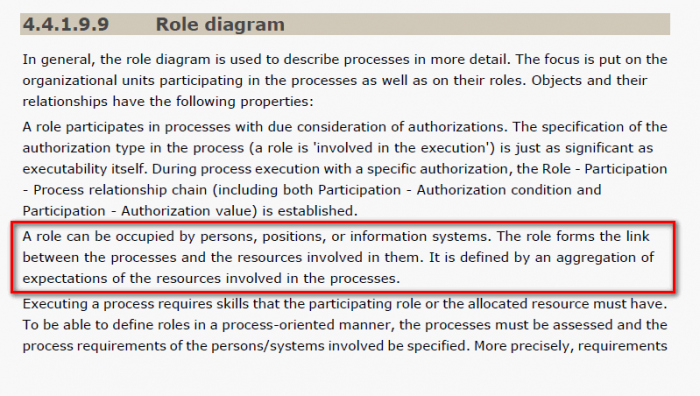Roles Vs. Positions?
- which to be used in EPC
- How to assign role to position (Using Matrix or Diagram)
- Do we need library model for both?
Regarding the information carrier, how is it linked to the data architecture? on what models?
How we can resemble policies and standards as objects in ARIS?
Hi Saad,
You've asked for so many questions in one post. Anyway, i will start with answering them:
In EPCs it is best to use Positons. The Positon is the smallest unit within the organizational structure and usually defined by the function or activity that an individual person/resource can handle. Role on the other had defines the type of employee/resource were certain skills/qualifications or KRAs. e.g. a role of consultant would require to have the qualifications such as a degree in management consulting and actual consulting experience. "From the point of view of positon, qualifications can be forced to meet certain requirements. In accordance with the paramter good match certain Roles are allocated to the Positions."
Role is perceived as a temporary where as positon can be permanent.
For further information, please write to me on deeptilad@gmail.com
Regards,
D
Hi Saad,
We use person types (roles) rather than positions. Depending on how your organizational roles are defined, you may choose to model two types of organization, one based on HR definitions, and one based on program / project / department roles. For example, perhaps my HR title is ENTETERPRISE SOLUTIONS SPECIALIST, but my relevant role regarding what my department or organization does might be Business Process Management Manager.
So we tend to use positions to represent job title and person type for role. Furthermore roles from an org design standpoint are often derived from skill requirements based on process requirements.
Everyone does it differently but this is just another perspective to take into account. Good luck.
Saad,
I am no expert either.
My understanding is, that e.g. the role "author" edits a document. In order to specify whether a line manager or the enterprise solutions specialist (which I would call position or function) executes this role (for the given activity) you can use the role diagram. Below is what ARIS method manual says about this, especially who can occupy a role. Others like to specify such things on the level of a function allocation diagram.
In the end, it depends on what you need. You can provide even more data if the role diagram is detailed with an authorization hierarchy diagram (e.g. if specific documents require specific authors).
As I see it, the difference between role and function (...) overwhelms most users. Deepti put it right, the role is always temporary, it ceases to exist if the associated process ends. However, there are orgs who use position or function names like "author xy", because this position is only to edit documents of type xy. So, you have to watch what people really mean when they talk about the author (and reviewer, etc.)
On another matter, I want to create a new Attribute type groups and subgroups. If I create a new Attribute type group, the previous created group is not displayed as superior group. Refresh configuration and re-starting ARIS did not help.
Am I doing something wrong?


.jpg)











